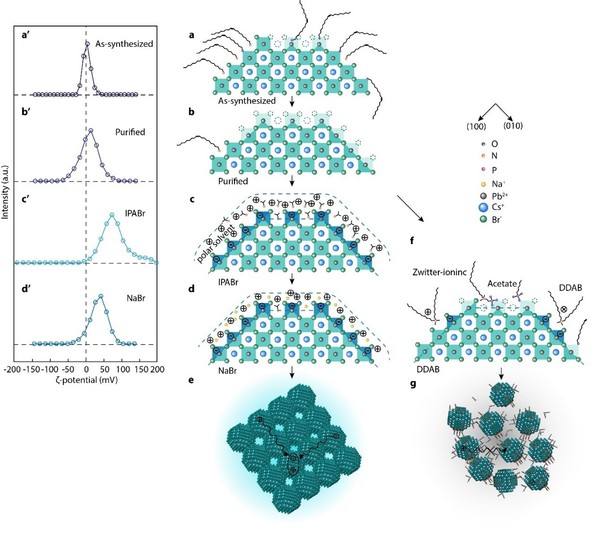Lead halide perovskite semiconductors are well-suited to applications such as solar cells and LEDs in view of their high defect tolerance, high carrier mobility and tunable emission over the visible and NIR ranges. QDs based on perovskites have emerged as promising materials in view of their high luminescence efficiency and narrow emission linewidth. Quantum confinement increases the binding energy of excitons, improving PLQY and positioning this material for use in next-generation LEDs. The PLQY was increased by nanosized grains (>100 nm); yet to take advantage of quantum confinement, it is necessary to bring the nanoparticle diameter into the range of the Bohr exciton radius, ~ 6-8 nm in the case of cesium and formamidinium lead halide perovskites. In addition to improving the PLQY, quantum confinement offers an additional method, beyond anion substitution, to tune the emission wavelength. Since ion migration during device operation leads to phase segregated regions of the different halides, and this leads to redshift in the emission profile upon application of an operating bias, confinement-based size-tuning may be an important route to blue perovskite LEDs. However, managing colloidal stability and passivation while retaining confinement is a challenge specific to perovskite QDs. Perovskite QD surfaces are terminated with LH+X- ion pairs, where LH+ represents the hydrated organic ligand and X- is a combination of long-chain carboxylate ligands and halide ions. The non-covalent ligand: surface bond in the case of perovskites results in dynamic ligand binding. The QD surface ions can be stripped off, along with the organic ligands, upon washing and drying (LH++Br- ⇋ L+HBr), destabilizing QD colloids and reducing the PLQY. When these QDs are cast into films, they tend to aggregate, losing PLQY and shifting in their emission wavelength.
Recently, one of the Ph.D. students from Prof. Liang-Sheng Liao’s group, Mr. Ya-Kun Wang, participated in Prof. Edward H. Sargent’s research project at University of Toronto, jointly reported a bipolar shell -- consisting of an inner anion shell and an outer shell comprised of cations and polar solvent molecules -- strategy to increase the carrier mobility and passivate defects of strongly quantum-confined CsPbBr3 QDs. Benefit from strong inter-dot coupling, they report CsPbBr3 perovskite QD solids that achieve up to a 100x increased carrier mobility compared with previously-reported low-dimensional perovskite solids. Levering the improved mobility, they fabricate CsPbBr3 QD-based efficient blue- and green light-emitting diodes (LEDs). The blue devices, which exploit the low trap density of the QD solids, achieve an external quantum efficiency (EQE) of 12.3%; and the green devices achieve an EQE of 22%.

Link to Paper: https://www.nature.com/articles/s41565-020-0714-5
Link to Prof. Liao’s Group:http://funsom.suda.edu.cn/funsomen/c4/00/c3002a50176/page.htm
Editor: Danting Xiang